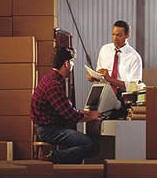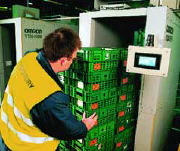Oct 07, 2002Oct. 7, 2002 - In the previous section of this Special Report, we talked about the importance of managing the cultural changes that RFID will bring. Change management starts at the top, and it starts with a vision.
There are two basic ways to implement an RFID system. One is to take a problem – the inability to keep track of certain assets – and assess how much it would cost to use RFID to solve that problem. Then, you calculate the return on investment. If the ROI looks good, you run a pilot, and if the pilot is successful, you deploy the system. That's the way most companies do it today. And that's the way most companies will do it even when there are an open standards. But they will get only a fraction of the potential benefits.
To get the full benefits of this powerful technology, companies will have to think strategically. They will have to fundamentally reshape their supply chains. Instead of manufacturers pushing product to retailers through the distribution centers, retailers will provide near-real-time data on consumer demand and pull product from manufacturing. For that to happen companies need to change the way they are organized and the way they run their operations.
Today, most companies run their supply chains from the top down. Software systems are designed to gather information and give senior managers the ability to make forecasts and develop plans to meet demand. It will be a major mind-shift getting generals at the top to delegate authority to field commanders in stores, warehouses and distribution centers so they can respond to conditions on the battlefield. And it will require changes in IT systems that we will explain in a later section of this report.
In order to make this fundamental shift, we believe that it is critical for CEOs and top executives to envision what their operations would look like if they could identify every asset they own and every product they make, move or sell. Then, they need to begin transforming their company's culture and moving step by step towards that vision.
The biggest challenge we see is getting CEOs to understanding that RFID is the future. In 1994, most CEOs had never heard of the Internet. As late as 1997, many were still scoffing at the notion that the Web would be important to their business. And in 1999 and 2000, they were wasting millions on Internet technologies because they feared they would be left behind.
In five to ten years, RFID will be as pervasive in business as the Internet is today. That's because RFID is the only automatic data collection technology that is truly automatic. It provides accurate, real-time data without human intervention. It can have a huge impact on many areas of a business. And while it clearly has limitations today – cost being just one – those limitations are being addressed.
There are, of course, plenty of CEOs around the world who realize that RFID has tremendous potential, but few, if any, see an imperative to adopting the technology today. After all, the much-hyped first-mover advantage didn't prove to be much of an advantage for those who launched Internet ventures. Why not wait until the technology is a little more mature, tag prices come down more and standards emerge?
It's a legitimate question. Right now, the RFID industry today is drowning in an alphabet soup of proposed standards – ISO, GTAG, ANSI, EPC and so on. This report is premised on the belief that the global, open network being developed by the Auto-ID Center will be adopted and will bring with it some de facto standards. But even if that fails to happen, it is clear that the industry will come to an agreement on standards before too long, which will make it possible to go beyond closed-loop implementations and gain efficiencies across the supply chain.
We also believe that tag prices will be addressed. There is a great deal of controversy surrounding the claim that Alien Technology, the Morgan Hill, Calif., startup that has developed the technology to assemble low-cost chips, will be able to produce a 5-cent RFID tag. The important point, to us, is not whether or when Alien can produce such a chip. It's that large companies have clearly shown that they want and are prepared to buy large quantities of tags if the price comes down. That means many vendors will compete to produce competitively priced tags. And there are clearly many, many applications that could deliver a healthy ROI using a 25-cent or 35-cent tag.
It is clear that tag prices will inevitably fall and standards will inevitably emerge. So the question becomes, Do companies wait for that to happen, or do they begin experimenting with a technology that can save them a little money today, with the expectation that it will save them large amounts of money in the future? Wal-Mart, Procter & Gamble, Unilever and others clearly believe it makes sense to start moving forward today.
Here is where vision becomes critical. No company can implement an RFID-powered supply chain over night, or even in two or three years. The investment in a complete, end-to-end RFID system and the related IT infrastructure will be in the hundreds of millions of dollars for Global 1000 companies. Not even Wal-Mart can afford to take that kind of risk. Moreover, a big bang approach would almost certainly be doomed to failure. The sheer volume of data would overwhelm companies.
It will likely take a decade to implement an end-to-end system. So how do you design a system that can be built in stages but will work as an integrated whole when complete? How do you ensure that when the system is finished, you wind up with something that provides exactly the kinds of information you need? And how do you change people's attitudes so they embrace this evolution and work for change, instead of against it?
Most companies, as we said, start with a business problem and run a pilot. That, frankly, is not going to help a company take advantage of a technology that is at least as important as the Internet. Why? Because putting readers in a warehouse won't help the marketing people figure out how to use RFID to boost sales. And running a point-of-sales pilot won't help the distribution people understand how RFID can reduce out of stocks. Moreover, most companies don't tie data from pilots into their operational software, so pilots provides precious little insight.
Pilots are important for tactical implementations, but RFID needs to be seen as a strategic change. That is, RFID is not the solution to a specific problem, but an infrastructure to build on. It can solve many problems at the same time, just as the Internet allows companies to sell to consumers, order from suppliers and perform many other critical tasks.
Failure to look at the big picture will mean a lot of wasted dollars. It's easy to envision a company spending a million dollars to automate a warehouse. The top executives are all very pleased that the system will save them $2 million a year. But then, someone points out that if the system could captured some extra data -- say, the temperature of goods in transit -- that information could be used to increase income from service-level agreements. Now the company has to spend another $750,000 to retrofit the system with temperature sensors and readers.
Before tackling any single problem, companies would do well to hire a consulting firm like McKinsey & Co. to analyze their business processes and come up with several key areas where a fully-fledged RFID system will provide major benefits. As the system is built out, companies with the right culture will find new and innovative ways of using the infrastructure to cut costs and increase sales, just as companies have with the Internet.
Once companies have a basic understanding of how RFID can transform two or three core areas of their business, they can begin small deployments that will provide a return on investment while also giving them hands-on experience with the technology and moving them toward a long-term goal. In the next section of our Special Report Low-Cost RFID: The Way Forward, we'll explain how manufacturers and retailers can automate receiving at distribution centers and move in stages toward transforming the DC into an engine of efficiency.
Companies don't have to spend millions on these initial projects. Automating receiving at a manufacturer's own distribution center can cost less than $100,000 for readers, tags and software integration. But companies should be sure to purchase equipment from vendors that offer a migration path to whatever standards emerge. Some readers for instance can download new software from the Internet, which enables them to use a new protocol. Many tags can also be reprogrammed.
It is important to understand the big picture. RFID is the third wave of business transformation. During the first wave, computers gave companies the power to crunch a tremendous amount of data (which was entered mainly by hand). During the second wave, which is still going on, the Internet gave companies the means to share data. In the third wave, companies will have the ability to collect data automatically with RFID.
Over the next year or two, we expect to see consultants start telling companies that they have to begin deploying RFID or risk being left behind. The fear factor drives business for these consultants. But speed is not the key issue. They key is having a strategic vision and creating a culture that can take advantage of the ability to collect real-time data. The companies with that kind of vision aren't the ones sitting around waiting for tag prices to drop to five cents. They're the ones busy figuring out how to use a new technology to outflank the competition.



